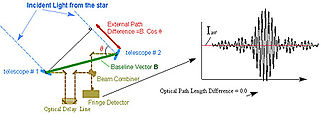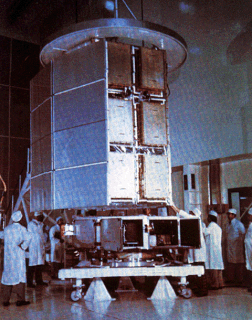Related Research Articles

Astrometry is a branch of astronomy that involves precise measurements of the positions and movements of stars and other celestial bodies. It provides the kinematics and physical origin of the Solar System and our galaxy, the Milky Way.

A star catalogue or star catalog is an astronomical catalogue that lists stars. In astronomy, many stars are referred to simply by catalogue numbers. There are a great many different star catalogues which have been produced for different purposes over the years, and this article covers only some of the more frequently quoted ones. Star catalogues were compiled by many different ancient people, including the Babylonians, Greeks, Chinese, Persians, and Arabs. They were sometimes accompanied by a star chart for illustration. Most modern catalogues are available in electronic format and can be freely downloaded from space agencies' data centres. The largest is being compiled from the spacecraft Gaia and thus far has over a billion stars.

Proper motion is the astrometric measure of the observed changes in the apparent places of stars or other celestial objects in the sky, as seen from the center of mass of the Solar System, compared to the abstract background of the more distant stars.

Hipparcos was a scientific satellite of the European Space Agency (ESA), launched in 1989 and operated until 1993. It was the first space experiment devoted to precision astrometry, the accurate measurement of the positions of celestial objects on the sky. This permitted the first high-precision measurements of the intrinsic brightnesses, proper motions, and parallaxes of stars, enabling better calculations of their distance and tangential velocity. When combined with radial velocity measurements from spectroscopy, astrophysicists were able to finally measure all six quantities needed to determine the motion of stars. The resulting Hipparcos Catalogue, a high-precision catalogue of more than 118,200 stars, was published in 1997. The lower-precision Tycho Catalogue of more than a million stars was published at the same time, while the enhanced Tycho-2 Catalogue of 2.5 million stars was published in 2000. Hipparcos' follow-up mission, Gaia, was launched in 2013.
The Minor Planet Center (MPC) is the official body for observing and reporting on minor planets under the auspices of the International Astronomical Union (IAU). Founded in 1947, it operates at the Smithsonian Astrophysical Observatory.

Gaia is a space observatory of the European Space Agency (ESA), launched in 2013 and expected to operate until c. 2022. The spacecraft is designed for astrometry: measuring the positions, distances and motions of stars with unprecedented precision. The mission aims to construct by far the largest and most precise 3D space catalog ever made, totalling approximately 1 billion astronomical objects, mainly stars, but also planets, comets, asteroids and quasars, among others.

The Smithsonian Astrophysical Observatory (SAO) is a research institute of the Smithsonian Institution, concentrating on astrophysical studies including galactic and extragalactic astronomy, cosmology, solar, earth and planetary sciences, theory and instrumentation, using observations at wavelengths from the highest energy gamma rays to the radio, along with gravitational waves. Established in Washington, D.C., in 1890, the SAO moved its headquarters in 1955 to Cambridge, Massachusetts, where its research is a collaboration with the Harvard College Observatory (HCO) and the Harvard University Department of Astronomy. In 1973, the Smithsonian and Harvard formalized the collaboration as the Center for Astrophysics | Harvard & Smithsonian (CfA) under a single Director.

HEAO-1 was an X-ray telescope launched in 1977. HEAO-1 surveyed the sky in the X-ray portion of the electromagnetic spectrum, providing nearly constant monitoring of X-ray sources near the ecliptic poles and more detailed studies of a number of objects by observations lasting 3–6 hours. It was the first of NASA's three High Energy Astronomy Observatories, HEAO 1, launched August 12, 1977 aboard an Atlas rocket with a Centaur upper stage, operated until 9 January 1979. During that time, it scanned the X-ray sky almost three times
6 Andromedae is an astrometric binary star system in the northern constellation of Andromeda. The designation comes from the star catalogue of John Flamsteed, first published in 1712. Its apparent visual magnitude is 5.91, which is just bright enough to be visible to the naked eye under good seeing conditions. Based upon an annual parallax shift of 34.1 mas as seen from Earth, it is around 96 light years from the Sun. It is moving closer to the Sun with a radial velocity of −32.4 km/s. The system has a relatively high proper motion, advancing across the celestial sphere at the rate of 0.272 arc seconds per annum.
The Tycho-2 Catalogue is an astronomical catalogue of more than 2.5 million of the brightest stars.
In astronomy, Durchmusterung or Bonner Durchmusterung (BD), is an astrometric star catalogue of the whole sky, compiled by the Bonn Observatory in Germany from 1859 to 1903. The name comes from Durchmusterung, a German word used for a systematic survey of objects or data. The term has sometimes been used for other astronomical surveys, including not only stars, but also the search for other celestial objects. Special tasks include celestial scanning in electromagnetic wavelengths shorter or longer than visible light waves.

Mu Cassiopeiae, Latinized from μ Cassiopeiae, is a binary star system in the constellation Cassiopeia. This system shares the name Marfak with Theta Cassiopeiae, and the name was from Al Marfik or Al Mirfaq (المرفق), meaning "the elbow". It is dimly visible to the naked eye as a point of light with an apparent visual magnitude of 5.16. The system is located at a distance of 24.6 light years from the Sun based on parallax, and is moving closer with a high radial velocity of −98 km/s. This star will move into the constellation Perseus around 5200 AD.
The Catalog of Components of Double and Multiple Stars, or CCDM, is an astrometric star catalogue of double and multiple stars. It was made by Jean Dommanget and Omer Nys at the Royal Observatory of Belgium in order to provide an input catalogue of stars for the Hipparcos mission. The published first edition of the catalog, released in 1994, has entries for 74,861 components of 34,031 double and multiple stars; the second edition, in 2002, has been expanded to provide entries for 105,838 components of 49,325 double and multiple stars. The catalog lists positions, magnitudes, spectral types, and proper motions for each component.
SAO or Sao may refer to:
The PPM Star Catalogue is the successor of the SAO Catalogue. It contains precise positions and proper motions of 378,910 stars on the whole sky in the J2000/FK5 coordinate system. It is designed to represent as closely as possible the IAU (1976) coordinate system on the sky, as defined by the FK5 star catalogue. Thus, the PPM is an extension of the FK5 system to higher star densities and fainter magnitudes.
The Catalog of Stellar Identifications (CSI) is a star catalog which was constructed to facilitate cross-referencing between different star catalogs. It contains designations and basic data for, as of 1983, approximately 440,000 stars, and was created by merging the Smithsonian Astrophysical Observatory Star Catalog, the Henry Draper Catalogue, the AGK2/3, the Cape Photographic Catalogue, the Cape Zone Catalogue, the Yale Zone Catalogue, the Cape Catalogue of Faint Stars, and the Boss General Catalogue. It contains stellar coordinates, magnitudes, spectral types, proper motions, and cross-references to designations in the previously mentioned catalogs. It also gives cross-references to many other catalogues, such as the Index Catalogue of Visual Double Stars, which have been linked to the CSI. The CSI eventually became part of the SIMBAD stellar database.
Catalog of 5,268 Standard Stars Based on the Normal System N30 is the 1952 auxiliary star catalogue created by Herbert Rollo Morgan to address proper motion inaccuracies in 19th century observations by converting contemporary catalogues from a mean epoch around 1900 to epoch and equinox 1950.0. However, the positions were derived from more than 70 recent catalogs with epochs of observation between 1917 and 1949. The N30 system is independent from any other astrometric system. Independent proper motions were determined by comparing the 1930 normal positions with the normal positions at the mean epoch, 30 years earlier, in the Albany General Catalogue, corrected by Morgan in 1948. Its primary use is the incorporation of 19th century astronomical data into modern research, and includes Harvard photometric magnitude, Henry Draper (HD) spectral type, and proper motion.

HV 2112 is a cool luminous variable star in the Small Magellanic Cloud. Until 2018, it was considered to be the most likely candidate for a Thorne–Żytkow object, but it is now thought to be an asymptotic giant branch star.

V915 Scorpii is an orange hypergiant variable star in the constellation Scorpius.
References
- ↑ Star Catalog: Positions and Proper Motions of 258,997 Stars for the Epoch and Equinox of 1950.0, Smithsonian Astrophysical Observatory Staff, Publications of the Smithsonian Institution of Washington, D.C., no. 4652, 4 vols., 1966 (reprinted 1971.)
- ↑ Webpage on the SAO star catalog, B1950
- ↑ Catalog translated to J2000
- ↑ Interactive query form of the catalog
- ↑ "SAO - Smithsonian Astrophysical Observatory Star Catalog". heasarc.gsfc.nasa.gov. Retrieved 2021-10-01.
- ↑ Millis, R. L.; Wasserman, L. H.; Birch, P. V. (1977). "Detection of rings around Uranus". Nature. 267: 330–331. Bibcode:1977Natur.267..330M. doi:10.1038/267330a0.